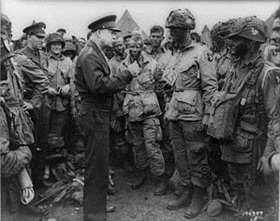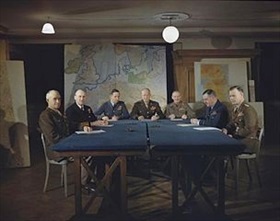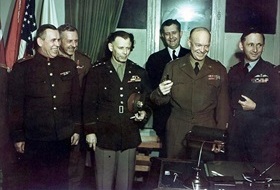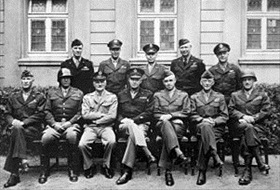EISENHOWER TO COMMAND U.S. FORCES IN EUROPE
London, England · June 24, 1942
On this date in 1942 Maj. Gen. Dwight D. Eisenhower arrived in London, England, to assume administrative and operational command of the European Theater of Operations, United States Army. Set up 16 days earlier, ETOUSA directed U.S. ground, air, and service operations north of Italy and the Mediterranean coast. When war broke out seven months earlier Eisenhower was working in Washington, D.C., in the Army’s War Plans Division. In March 1942 the brigadier general was promoted to major general and appointed to head the War Department’s Operations Division, holding the title Assistant Chief of Staff to Gen. George C. Marshall, with responsibility for creating the major war plans to defeat Japan and Germany.
A month after arriving in England in 1942, the 51-year-old Eisenhower was chosen to lead the assault on Vichy French Africa, despite never having had hands-on command of a single combat unit. During their Christmas meeting the previous year in Washington, D.C., President Franklin D. Roosevelt and British Prime Minister Winston Churchill were keen to grab Adolf Hitler’s attention in order to keep Soviet leader Joseph Stalin from pursuing a separate peace with Nazi Germany. A separate peace could divert millions of the enemy to Western and Southern Europe. Eisenhower’s brilliance at commanding a desk in Washington eventually paid huge dividends when he translated military strategy into practical action (Operation Torch) that began on November 8, 1942, the successful six-month Anglo-American struggle to oust German and Italian forces from North Africa.
After Torch, Eisenhower (now a four-star general) oversaw the invasion of Sicily (Operation Husky) and the Italian mainland. In December 1943, Eisenhower was tapped for the role of Supreme Allied Commander in Europe. In January 1944, after a ten-month absence, he returned to head ETOUSA and in February was elevated to Supreme Allied Commander of the Allied Expeditionary Force (SHAEF). In these positions the once Chief of the War Plans Division in Washington was tasked with planning and executing the liberation of all of Western Europe and the doomsday invasion of Hitler’s Germany in the West. Until the war’s end in Europe on May 8, 1945, Eisenhower juggled operational command of all Allied forces as well as administrative command of U.S. forces north of the Alps.
![]()
General of the Army Dwight D. Eisenhower, 1890–1969
 |  |
Left: This iconic photo, taken on the evening of June 5, 1944, the day before the Normandy landings, captures Gen. Eisenhower speaking with U.S. paratroopers of Company E, 502nd Parachute Infantry Regiment, 101st Airborne Division at Greenham Common Airfield in England. He was there to give the Order of the Day: “Full victory—nothing else.” In Lt. Wallace C. Strobel’s memoir (seen wearing the number 23 around his neck), Eisenhower was also talking about fly fishing with the men, something he liked to do before a stressful operation.
![]()
Right: SHAEF leadership at their London headquarters in early 1944. Left to right: Lt. Gen. Omar Bradley, Commander in Chief, 1st U.S. Army Group; Adm. Sir Bertram H. Ramsay, Allied Naval Commander in Chief, Expeditionary Force; Air Chief Marshal Sir Arthur W. Tedder, Deputy Supreme Commander, Expeditionary Force; Gen. Dwight D. Eisenhower, Supreme Commander Allied Expeditionary Force; Gen. Bernard Law Montgomery, Commander in Chief 21st Army Group; Air Chief Marshal Sir Trafford Leigh-Mallory, Allied Air Commander, Expeditionary Force; and Lt. Gen. Walter Bedell Smith, Chief of Staff to Eisenhower. By the end of 1944, Eisenhower, through SHAEF, commanded three powerful army groups. In the north the British 21st Army Group commanded by Montgomery; in the middle the U.S. 12th Army Group, largest and most powerful U.S. Army formation ever to take to the field, commanded by Bradley; and in the south the U.S. 6th Army Group commanded by Lt. Gen. Jacob L. Devers.
 |  |
Left: Senior Allied leaders celebrate at SHAEF HQ, Reims, France, early on the morning of May 7, 1945, shortly after Eisenhower had addressed the German mission, which had been sent by German President Adm. Karl Doenitz (Hitler’s successor) to sign the unconditional surrender document. Present are (left to right) Gen. Ivan Susloparov (Soviet Union), Lt. Gen. Frederick E. Morgan (British Army), Lt. Gen. Walter Bedell Smith (U.S. Army), Harry C. Butcher (U.S. Navy), General of the Army Dwight D. Eisenhower (holding fountain pens that were used during the signing ceremony), and Air Marshal Arthur W. Tedder (Royal Air Force).
![]()
Right: Key American generals in Europe, 1945. Eisenhower is seated in the middle. To his right are William H. Simpson, George S. Patton, and Carl A. Spaatz. To his left are Omar Bradley, Courtney H. Hodges, and Leonard T. Gerow. Standing are (from left to right) Ralph F. Stearley, Hoyt Vandenberg, Walter Bedell Smith, Otto P. Weyland, and Richard E. Nugent.
U.S. Army Biography of General of the Army Dwight D. Eisenhower
![]()

 History buffs, there is good news! The Daily Chronicles of World War II is now available as an ebook for $4.99 on Amazon.com. Containing a year’s worth of dated entries from this website, the ebook brings the story of this tumultuous era to life in a compelling, authoritative, and succinct manner. Featuring inventive navigation aids, the ebook enables readers to instantly move forward or backward by month and date to different dated entries. Simple and elegant! Click
History buffs, there is good news! The Daily Chronicles of World War II is now available as an ebook for $4.99 on Amazon.com. Containing a year’s worth of dated entries from this website, the ebook brings the story of this tumultuous era to life in a compelling, authoritative, and succinct manner. Featuring inventive navigation aids, the ebook enables readers to instantly move forward or backward by month and date to different dated entries. Simple and elegant! Click 











